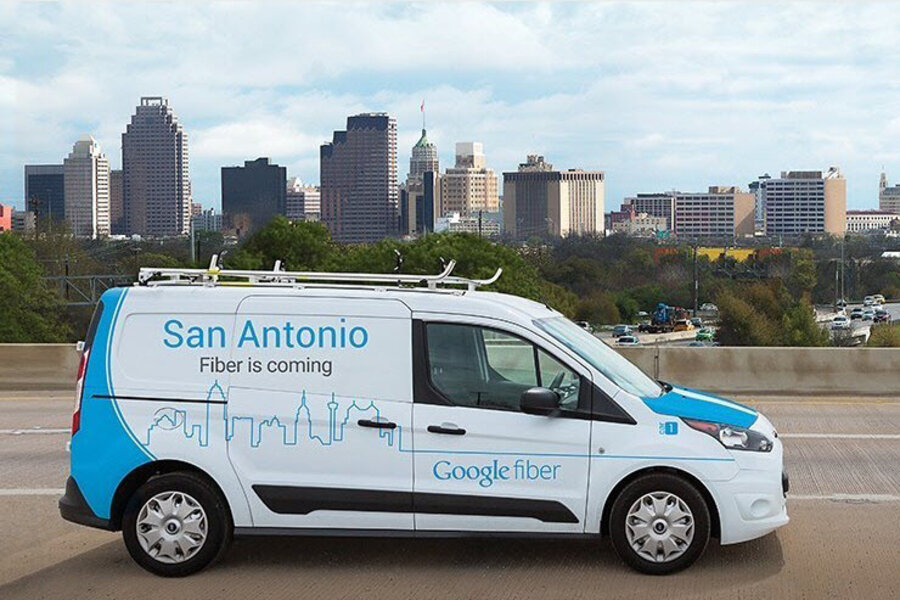Why Google is now offering a landline phone powered by fiber Internet
Loading...
Google is expanding its high-speed Fiber Internet service into an older arena – landline phones.
The service, which costs $10 per month, offers unlimited local and nationwide calls, caller ID, call waiting, and 911 emergency service. International calls are offered at the same rates as the company’s web-based Google Voice service.
Because it’s a cloud-based service, the company’s Fiber Phone will work on any tablet, laptop, or wireless phone, in addition to being compatible with a traditional landline phone, the company says.
“Landlines can be familiar, reliable and provide high-quality service, but the technology hasn’t always kept up. That’s why today, we’re introducing Fiber Phone as a new option to help you stay connected wherever you are,” wrote John Shriver-Blake, a product manager for Google Fiber, in a blog post on Tuesday.
New customers can either keep their existing phone number or pick a new one and connect their phone to the Fiber Phone box.
The catch is that the new phone service will only be available to customers in cities where Google’s Fiber service is offered — currently Kansas City; Austin; Atlanta; and Provo, Utah, though it is either currently building or considering offering service in a range of other locations.
Google is particularly pitching its fiber-powered phone service as a blend of old and new.
In addition to being able to access the service while away from home, users will be able to receive transcripts of their voice mail messages as a text message or email. That builds on a feature currently offered to people who use Google Voice.
Having access to a larger number of voicemail messages could also help the company improve its system for transcribing messages, which can be hampered by factors such as a message that isn’t in English or if there is background noise.
Previously, the company has offered users an opportunity to opt-in to a system that would strip their messages of their account information and then analyze them to improve its language processing technology.
While they’re often heralded as a thing of the past, landlines also aren’t all that uncommon. More than 41 percent of families had both landlines and wireless service, while nearly 8 percent had only a landline, a survey of 20,000 households conducted last year by the Centers for Disease Control found.
While the number of households with a landline — both with and without cellphone service — has decreased significantly in recent years, the CDC found, the number of people without a phone at all had increased, to 3.4 percent.
But Google’s entry into the landline phone market doesn’t sidestep one potential pitfall for users — phone service that works using a cable or fiber optic network will go down if a user experiences a power outage, something that isn’t a concern with many traditional copper-based phone lines as long as the phone isn't cordless.
To compensate, cable companies such as Comcast regularly equip their phones with battery backups, which can last about eight hours.
But some users say that cable companies that traditionally offered both a copper phone line and a fiber optic connection — particularly Verizon — have made an aggressive push to get users to drop their copper phone lines.
That effort could have serious consequences for users who face long-term power outages, such as during a natural disaster, when copper lines can often offer a stable connection even if users lose their power or Internet service.
“Going through Hurricane Sandy, I had no power for 12 days, and I was the only one on the block who had phone service,” Mike Keys, who lives in Huntington, New York, told tech site The Verge, describing the crippling impact of the 2012 hurricane. “Everyone else switched to the cable company or FiOS. At the beginning of my block, a tree fell on the lines, and this is interesting, it took out the electricity, it took out cable TV, it took out FiOS, but it did not bring down the copper cable."
For the past several years, the FCC has been considering whether to classify services that use the Internet for phone service as a public utility.
Google’s Fiber hasn’t been immune from outages, such as one that occurred in Kansas City last October, which happened to coincide with the first game of the World Series.
It’s still unclear why the company decided to branch further into using its Fiber network to provide home phone service, though some note that could be a way to avoid regulatory obstacles to expanding its fiber-optic network.
Earlier this year, Google announced plans to either build new networks or partner with cities to tap into fiber optic networks they plan to build over the next few years in Huntsville, Al.; Salt Lake City; San Antonio, Texas; Nashville, Tenn.; Charlotte and the Raleigh-Durham area in North Carolina; and some parts of San Francisco.
The tech giant is also considering the expansion of Fiber to several other cities, including Chicago; Jacksonville and Tampa, Fla.; parts of southern California; Louisville, Ky.; and Oklahoma City.





